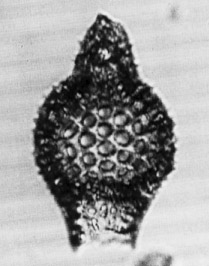 Lamptonium
fabaeforme chaunothorax Riedel and Sanfilippo
Lamptonium
fabaeforme chaunothorax Riedel and Sanfilippo Lamptonium
fabaeforme chaunothorax Riedel and Sanfilippo
Lamptonium
fabaeforme chaunothorax Riedel and SanfilippoLamptonium(?) fabaeforme(?) chaunothorax Riedel and Sanfilippo, 1970, p.524, pl.5, figs.8-9
Similar to the nominate subspecies, but with larger thoracic pores (Riedel and Sanfilippo, 1970) See Description of L. fabaeforme fabaeforme herein.
Length excluding horn 195-285 µm, of cephalothorax 160-235 µm. Maximum breadth 120-175 µm.
L. f. chaunothorax is distinguished from its ancestor L. f. fabaeforme by the larger thoracic pores, from its descendant L. f. constrictum by not having a distinct constriction in the upper part of the thorax, and from L. sanfilippoae by the horn not being covered by a massive layer of rough shell material (Sanfilippo et al., 1985).
The spherical cephalis, enclosed by the thick wall continuing upward from the thorax, bears a conical to bladed horn of variable length. The base of the horn also is sometimes obscured by this thickened wall. Thoracic pores are large, less than eleven pores (often as few as eight) around half the circumference, irregular in size, with small thorns projecting inward from the margin. Shell wall thick, and roughened by thorns. The subcylindrical to tapering abdomen is short, with irregularly scattered pores, distally hyaline, and with no differentiated margin (Sanfilippo et al., 1985).
This species is found in most low- to middle-latitude assemblages of early to middle middle Eocene age, and occurs sporadically. Its morphotypic first appearance lies within the Bekoma bidartensis Zone and its morphotypic last appearance lies within the Thyrsocyrtis triacantha Zone.
L. f. chaunothorax is member of the lineage leading from L. pennatum to L. f. constrictum.
Additional illustrations can be found in Foreman, 1973, pl.6, figs.10-12.